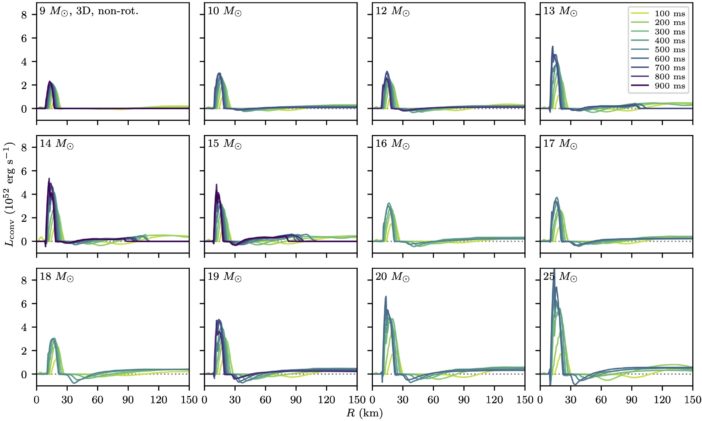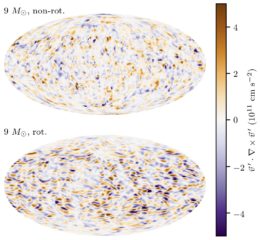Editor’s note: Astrobites is a graduate-student-run organization that digests astrophysical literature for undergraduate students. As part of the partnership between the AAS and astrobites, we occasionally repost astrobites content here at AAS Nova. We hope you enjoy this post from astrobites; the original can be viewed at astrobites.org.
Title: On the Origin of Pulsar and Magnetar Magnetic Fields
Authors: Christopher J. White et al.
First Author’s Institution: Princeton University
Status: Published in ApJ
Magnetic fields at the surface of a neutron star can reach up to one quadrillion times the strength of those on Earth — that’s a factor of one followed by fifteen zeros. If you were to step foot on a neutron star, the scrambling of your credit card data would be the least of your worries. At these magnetic field strengths, the supposed emptiness of space starts to refract light and light itself splits into matter and antimatter. If a frog starts levitating in fields one hundred thousand times stronger than Earth’s, who knows what would happen to a frog on a neutron star!
So, how did these magnetic fields get so strong?
Cooking Up a Neutron Star Core
First, let’s step back a bit and review how neutron stars form. In short, neutron stars are the remnants of old, massive stars. When a massive main-sequence star (typically between 8 and 25 times the mass of the Sun) runs out of fuel for fusion in its core, the core becomes degenerate, meaning that peculiar quantum mechanical effects prevent the core from collapsing. However, as more matter piles onto the degenerate core and the core exceeds the Chandrasekhar mass, the core contracts and heats up to billions of kelvin, forcing electrons and protons to combine into neutrons, releasing a deluge of high-energy neutrinos in the process. This “proto-neutron star” core continues to contract until it reaches the density of an atomic nucleus. Meanwhile, the infalling outer regions of the original star bounce off the degenerate core and are expelled by the outgoing neutrinos, resulting in the violent explosion of the star via a core-collapse supernova. When the dust settles, all that’s left is the neutron star core.
Well, then, how does this core-collapse process relate to the extreme magnetic fields possessed by neutron stars? One explanation is that the number of magnetic field lines threading the surface of the contracting proto-neutron star must stay fixed, so, as it shrinks, the field lines bunch together and amplify the total field strength. However, this model fails to capture the dichotomy between radio pulsars — rapidly rotating neutron stars with relatively lower magnetic field strengths (typically between 1011 and 1013 times as strong as Earth’s field) — and magnetars — slowly rotating neutron stars with exceedingly powerful magnetic fields (reaching up to 1015 times as strong as Earth’s). With this dichotomy in mind, the authors of today’s article propose a new avenue for the growth of neutron star fields: convective dynamos in collapsing proto-neutron star cores.

Figure 1: A cartoon illustration of dynamo action inside Earth. The motion of the convecting liquid iron of the outer core is organized into coils by Earth’s rotation, thus generating large-scale magnetic fields. [Andrew Z. Colvin (via Wikipedia)]
Stirring Up Magnetic Fields
Dynamos are responsible for generating and maintaining the magnetic fields of a wide array of astronomical objects, from young protostars and old, dim M dwarfs to the gas giants of the outer solar system to Earth itself (see Figure 1). If an astrophysical body is filled with electrically conducting fluid that’s continually undergoing convection (like the liquid iron in Earth’s outer core), the rotation of the body will cause these convecting electrical currents to twist into elongated coils, thus producing large-scale magnetic fields — this is the fundamental mechanism of dynamo action.
We can quantify the strength of a convective dynamo via the Rossby number, the ratio of the speed of fluid convection to the speed of the body’s rotation; a slowly rotating body containing vigorously convecting fluid will have a high Rossby number, while a fast-rotating body with weaker convection will have a low Rossby number. A natural dichotomy in magnetic field strength arises from a threshold value for the Rossby number: dynamos with Rossby numbers below this threshold tend to produce stronger dipolar fields (like Earth’s) that scale with the strength of convection, while dynamos with Rossby numbers above the threshold tend to produce weaker fields with multiple poles. Since proto-neutron stars are expected to undergo convection during core-collapse, dynamo action and this Rossby number dichotomy could explain the split between pulsars and magnetars.
Today’s authors thus turn to simulations of proto-neutron star formation in core-collapse supernovae to test this hypothesis. In a suite of 12 supernova simulations with non-rotating progenitor stars ranging from 9 to 25 solar masses (plus one simulation featuring a rotating 9-solar-mass progenitor), the authors look at the convective power and the geometry of the fluid flow in the interiors of the developing proto-neutron stars; from these observations, the authors can infer the magnetic field strengths of the resulting neutron stars. Figure 2 shows the convective power as a function of radius for each of the simulations without rotation, demonstrating that convection becomes stronger with larger progenitor mass. Meanwhile, Figure 3 shows a comparison of the flow geometry between a simulation with a rotating progenitor vs. one without rotation, demonstrating the relative complexity of the flow in a rotating proto-neutron star. The fact that the interiors of rotating proto-neutron stars are capable of sustaining vigorous convection and complex fluid flows implies that dynamos in proto-neutron stars should be able to generate strong magnetic fields.

Figure 2: Convective power vs. radius in the 12 supernova simulations (with non-rotating progenitor stars) analyzed by the authors. The color gradient represents the time since the infalling outer region of the progenitor has “bounced” off the degenerate core. These plots show a general trend of increasingly vigorous convection with increasing progenitor mass and with increasing time since bounce. [White et al. 2022]
Completing the Recipe

Figure 3: Complexity of the fluid flow (or, in hydrodynamics jargon, the “kinetic helicity”) near the surface of the proto-neutron star in supernova simulations with a 9-solar-mass non-rotating progenitor (top) and with a 9-solar-mass rotating progenitor (bottom). The proto-neutron star in the simulation with the rotating progenitor has developed more extreme, complex structures. [White et al. 2022]
Original astrobite edited by Suchitra Narayanan.
About the author, Ryan Golant:
I am a second-year astronomy Ph.D. student at Columbia University. My current research involves the use of particle-in-cell simulations to study magnetic field growth in gamma-ray burst afterglows and closely related plasma systems. I completed my undergraduate at Princeton University, and I’m originally from Northern Virginia. Outside of astronomy, I enjoy learning about art history, playing violin and video games, and watching cat videos on the internet.
